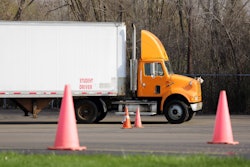
The Commercial Vehicle Safety Alliance’s (CVSA) Operation Safe Driver Week set for July 9-15 will focus on speeding, the No. 2 driver violation in the U.S. based on Federal Motor Carrier Safety Administration data from September to present, according to Kerri Wirachowsky, director of inspection programs at CVSA.
During a recent webinar “Mastering Fleet Compliance and Safety Regulations: An Inside Look with CVSA,” hosted by vehicle lifecycle management software provider Solera, Wirachowsky walked the audience through the top vehicle and driver violations. On the driver side, she said the No. 1 violation is failure to obey traffic signals. On the vehicle side, she said the No. 1 violation is lighting.
But the webinar focused heavily on eRODS (Electronic Record of Duty Status) violations, which came in at No. 3 on the driver side. With the recent enforcement of electronic logging devices (ELD) in Canada, Wirachowsky said it is important for motor carriers that operate in both places to educate their drivers on cross-border operations and the differences in regulations to avoid eRODS citations.
“My advice to people that are going back and forth, make sure your driver knows, particularly if it's paper, the difference between what he's supposed to produce to an American inspector and what he's supposed to produce to a Canadian inspector because they're not the same at all,” Wirachowsky said.
She said inspectors generally aren’t trained on the rules outside of their jurisdictions. For example, Canadian inspectors are trying to understand the difference in what they were looking at before – automatic onboard recording devices – versus what they’re looking at now: ELDs. It’s causing a lot of confusion, Wirachowsky said.
Florence Dougherty, director of product management at Omnitracs said motor carriers need to educate drivers on how to make sure their ELD is representative of the jurisdiction they're in.
“What's happening is you are allowed to drive under Canadian rules, so when in Rome, and anybody on this call that travels in both knows that the Canadian rules are higher: 13 hours driving, 14 hours on duty and 16 hours elapsed. Down in the U.S. it's 11 and 14,” Wirachowsky said. “So when you go to Canada, sure, you can drive 13 hours, you can be on duty 14, and you can do an elapsed of 16, but you need to reset yourself before you come back into the United States.
“My suggestion is don't stop so close to the border that your ELD is pinging on the other side (a U.S. location). If you are going to use Canadian rules, you have to be able to articulate that to the inspector at roadside because some inspectors are just looking at the eRODS, and they see 12 hours driving, and they don't maybe pay attention to the fact that the guy was north of the border,” she said. “Most of the northern border inspectors are familiar with the Canadian rule set, but once you get down past the Mason Dixon Line, that's not necessarily the case. Now when they're plugging in eRODS, (it) shows them potential violations in eight days, so they could have easily been in Canada six, seven days ago, and they (inspector) just see that he drove for 12 hours … and they charge the driver, put them out of service, when in fact he was okay doing so.”
Wirachowsky said CVSA is working on a learning management course for cross-border travel that outlines the differences between Canada and the U.S.’s hours of service.
In the U.S., for example, drivers can use personal conveyance, which Wirachowsky said she believes is the primary cause of eRODS violations. In Canada, inspectors will add back the time a driver spent on personal conveyance if it is not done per Canada’s rules. She said they will also add back any time spent in the U.S.’s agricultural exemption.
“When you go to Canada, that six hours or eight hours or however long you spent in that ag exemption all gets put back into your cycle, so be careful with that,” she said. “It can still work for you because the cycle requirements are different: 70 hours in seven days versus 70 in eight in the U.S., so there is a variance there. If you really know what you're doing, and you can do it well and you can do it right, you can use the rules in both countries to your advantage.”
But doing it wrong can get you into trouble, she said.
eRODS falsification violations have been going up and up ever since the implementation of ELDs in the U.S. The No. 1 reason for that in Wirachowsky’s opinion is misuse of personal conveyance (PC).
“I've seen logs and records of duty status that inspectors have provided to me where the driver is at his 11 hours or his 14, and then he just flips it into PC and keeps going. He's using this ‘I’ve got to get to a safe haven’ as his as his excuse; you can't do that,” she said. “If you're at your driving limit, you need to start looking for a place of rest when you're at your 13th hour, not at your 14th hour and one minute … You’ve got to plan your day a little bit better because if you start moving in the direction of the load post that 14 or 11 hours, you are misusing personal conveyance.”
She said she isn’t suggesting there are more false records of duty status out there than there was 10 years ago but instead that ELDs make it much easier to find them.
“Because I see false logs rising in violation, and because I see the other stuff disappearing, I think ELD does help keep motor carriers and drivers honest far more than a paper log ever did,” Wirachowsky said. “It's just easier for roadside to detect falsifications than it is on paper logs.”













